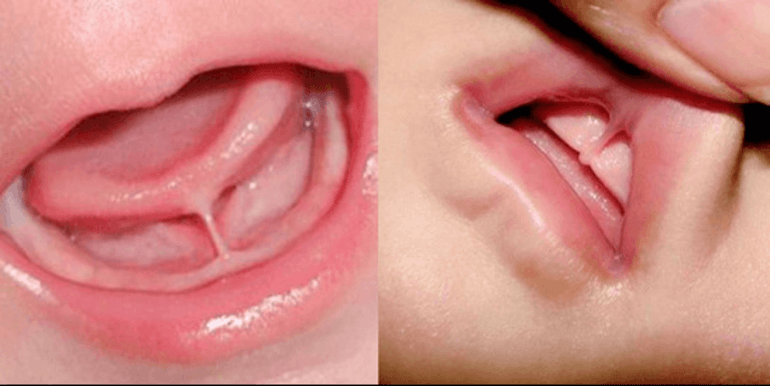One of the most controversial issues in breastfeeding is the role of the tongue and lip-tie. Just about every medical and parenting website discusses these
diagnoses, as they are certainly on the rise. So, what is the deal with tongue and lip-ties, and how can you tell if your baby has one or not?
What is a tongue tie?
If you are new to breastfeeding, you likely have never heard of tongue or lip-ties before. A tongue-tie, medically known as ankyloglossia, is when the tissue that
connects the tongue to the bottom of the mouth – the frenulum – is too tight or thick. This tightness/thickness limits the tongue’s range of motion. For babies, this
creates difficult feeding.
There are four clinical classifications for tongue ties based on where the tie is located
● Class 1: Tie is located at tip of tongue
● Class 2: Tie is located behind the tip of the tongue; it may attach on or just behind the alveolar ridge
● Class 3: Tie is located closer to the base of the tongue
● Class 4: These ties tend to be located under a mucus membrane, which means they are hard to feel and thus hard to diagnose
The classification of tongue-ties helps identify where the tie is located, but it doesn’t indicate the severity. Each class is considered a tongue tie, which may or
may not affect feeding, and should be addressed with a lactation consultant and/or pediatric dentist.
What causes tongue-tie?
Healthcare professionals don’t know exactly what causes tongue-tie, but there are several theories. Some studies propose that tongue-tie is inherited but there
is no clinical evidence to prove this. No matter the cause, tongue-tie is present from birth, and nothing that was done or not done caused it to occur.
What is lip-tie?
Lip-ties are the same thing as a tongue-tie, but on the lip. It is when there is tissue connecting the upper lip to the upper gum. Lip-tie tissue can be too thick, too
tight, or both. Like with tongue-ties, lip-ties can potentially cause problems, but effects are less notable than with tongue-tie. If your baby has a lip-tie, they
should also be evaluated for potential tongue-tie. Lip-ties are classified in a way that indicates the location of the tie.
● Class 1: Little to no visible attachment
● Class 2: Frenulum with no restriction apparent
● Class 3: Lip-tie with central restriction
● Class 4: Lip-tie with central restriction and bone notching
While a tongue-tie is closely linked to breastfeeding problems, there’s less evident that a lip-tie does the same thing. That’s because of the different role of the
upper lip during nursing – its function is to form a seal and rest in a neutral flanged position against the breast.
What causes lip-tie?
Similar to with tongue-ties, experts do not know what causes lip-ties. There is an observed overlap between individuals with both tongue and lip-ties.
How do they affect breastfeeding?
Although moms can successfully breastfeed through many challenges, a tongue-tie is a major cause of breastfeeding problems. Because babies with tongue
ties have less mobility in their mouths, they have more difficulty making a good latch onto the breast. A poor latch can cause: nipple injury, breastfeeding pain,
inadequate milk transfer, clogged ducts, mastitis, slow weight gain or weight loss, low supply, as well as other issues. In addition to these issues, you may notice
clicking or smacking sounds from your baby, or that their lips are tucked in during nursing instead of flanging out. Your baby may also seem unsatisfied during or
after a feed.
How to identify tongue and lip-ties?
If you are concerned about a tongue or lip-tie, the best thing to do is contact a lactation consultant or get a referral to a pediatric dentist who specializes in these
conditions. Visual charts and classifications can be helpful, but you should also look out for symptoms that you and your baby experience.
Fixing tongue and lip-tie conditions
Once you’ve identified a tongue or lip-tie, you need to evaluate options for resolving it. A pediatric dentist may suggest a tongue or lip-tie revision surgery or a
frenotomy. A frenotomy is recommended when a tie is keeping them from latching and nursing properly. Most moms are worried about their babies having
surgery at a young age, but revision procedures are quick and don’t require anesthesia. While revisions are effective, it is important to follow aftercare
instructions to keep the tie from reattaching and causing continued restriction.
There is a lot to figure out about tongue and lip-ties! If you’re ever wondering what you’re experiencing is normal or not, we are here to help!
Original source from the American Dental Association



